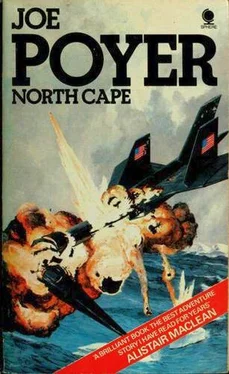Complete and utter silence had descended over the vast reaches of the North Cape. Along the shore the storm-raised combers continued to pound against the rock with monotonous regularity. But inland nothing moved on the plain of snow. It was as if the cold had frozen even the air into immobility. Folsom knelt down by Teleman’s body and turned him over slowly. He pushed back the neck flap, pulled off one of his own gloves and felt for a heartbeat.
“I’ll be damned. He’s still alive,” he said wonderingly. “You’re kidding,” Gadsen said, dropping down beside him. “How the hell could he be?” Folsom shook his head and rebuttoned Teleman’s neck flap. “You’ve got me. Now, how do we get him out of here?”
McPherson shrugged out of his pack and reslung his rifle. “I’ll carry him.”
The strident sounds of the battle alarm echoed through the ship. No practice situation now; each crew member understood fully that this was the real thing. Lieutenant Commander Bridges, strapped into the seat of the executive officer’s console, watched the battle lights flick from amber to green as each station reported in. A hard knot of both fear and excitement was building in his stomach as the track of the submarine, relayed to his console from the large bridge display, began to move steadily towards the battle cruiser.
“All stations manned and ready, sir,” he reported, as the last light, the security room, turned green.
“Thank you, Mr. Bridges,” Larkin said calmly. “Bring her around on a course of op° and ten knots, rig for silent running. All ECM to on.”
Bridges punched the heading into the computer console and stabbed down the ECM gear switch. The computer control net within the ship allowed either the captain or the executive officer to control the ship during battle stations, thus avoiding the delays encountered in relaying orders through the helmsman and then to the engine room. Larkin still preferred to sit aloof on his high seat and give orders, leaving it to the executive officer to handle the ship. No provisions had been made for controlling the ship from any other location, nor was there need. In nuclear sea warfare there is no such item on the shipwright’s bill of materials as armor plate. And conventional weapons were of no value against the U.S.S. Robert F. Kennedy , as she was well,protected by her speed, defensive weaponry, and ECM gear. A direct hit on the bridge would not matter. A hit with nuclear weapons within 500 yards would destroy her utterly. Within one mile, a direct hit would probably kill the entire ship’s complement with radiation. Larkin had not moved his eyes from the holographic map display since the Russian submarine had turned toward them and begun to run out to sea, directly away from North Cape Island, where it had lain since early that afternoon. Since 1500 the RFK had tried in vain to maintain a radar and sonar watch on the submarine, but its proximity to the rock walls of the cliffs edging the island had created a maze of conflicting signals. All during the long afternoon and evening, the feeling that the Russians had indeed landed a second party had grown. Now, with the submarine moving for a third time, it could mean either that the Soviet commander had realized his mistake and was moving to land a third party ashore between Folsom and the naval base, or that the RFK had been spotted. Long, agonizing minutes passed with the speed of a glacier’s tread as the submarine increased its speed to twenty-two knots on a course that would bring an intercept in less than an hour. Finally, after twenty minutes, the submarine came about to a course paralleling the west coast. Larkin let loose a sigh of relief that was lost in similar sounds from the other eight men on the bridge. The submarine was still unaware of their presence. But an even greater dilemma now presented itself to Larkin. His theory, that the submarine was moving down the coast to drop the third shore party as close to the unsuspecting naval base as it dared, from which they would then work their way back to meet Folsom, was confirmed.
He knew that he could trust Folsom to avoid capture as far as possible. But Folsom was surrounded and probably not even aware of it. As he weighed the possibilities, the choices became clear to him.
As captain of the U.S.S. Robert F. Kennedy , and responsible not only for the safety of the ship but his own shore party and the downed pilot, Larkin indeed had a choice to make: reveal his position to the submarine and engage, or wait until the third shore party was dropped and move in to destroy the submarine and save his own landing party with whatever fire support he could provide. The first choice was the more logical, but its danger lay in the fact that the Soviets had already expended a great effort to capture Teleman, and it was more than likely that the submarine would turn and fight rather than run. If that happened, it could very well be the start of, if not a third world war, then a major freeze in East-West relations, which could be even more disastrous in the long run. A third possibility, that Teleman would be captured and taken aboard the submarine, which would then be sunk, to Larkins credit, never even suggested itself.
Larkin, very uncharacteristically, had sent off a blistering message to Virginia with instructions to relay to Washington and the White House Position Room for immediate action. The message had laid down in no uncertain terms exactly what would happen if the submarine was allowed to disgorge its human freight. Minutes ago a terse message had come in over the direct channel ordering him to wait for orders. Now he sat at the command console, the power and weaponry of an entire World War II Navy at his command rolled into one single ship, and he was powerless. All he could do was shadow the submarine at a distance of eighty miles. It was now obvious to Larkin that the submarine commander was heading for a sheltered spot on the western. coast of the North Cape to drop a third landing party. The Soviet skipper was obviously going to attempt to take advantage of the bad sea conditions as cover *for his landing party above the Norwegian naval base. If he did so, all hope for Folsom and his party outrunning the other two parties was gone. They would fall right into the arms of this third party. Larkin was caught in a quandary and his helplessness showed in the steady drumming of his fingers on the console panel. He decided to wait. The submarine was now moving around the lee of the North Cape. and into the weather side, exposed to the wind and waves that screamed down from — the Great Barrier across two hundred miles of open sea. It was just possible that the submarine would not be able to spot a location where a third shore party could be landed.
The U.S.S. Robert F. Kennedy dug into the waves as Larkin ordered her speed increased to fifteen knots. She burrowed into the high waves and thrust forward, white water breaking around her bow as she swept on, running for position off.the mouth of the fjord.
“Hold his head up a little higher… he’ll choke if…” Teleman did choke as the steaming hot tea dribbled in equal portions down his chin and throat. He coughed wealdy, tried to sit up, and found he could not.
“I’ll be damned,” he heard someone say. “I never thought he’d wake up again.” He managed to open his eyes, focus on the face above, but it was a moment or two before he recognized Folsom beneath the beard and cold blisters. He lay back exhausted until a heavy voice, speaking a guttural language, brought him bolt upright, mind clear and sharp for the first time in two days. In back of Folsom was a parka-clad. figure holding a rifle loosely but ready on the back of Folsom’s head. Beyond the Russian soldier were several more, all crowded into the tent, heads bent together as they talked. Every few moments one of them would look over at him, a smite of victory on his face. He found Gadsen and McPherson, both cramped against the tent wall with their hands and feet bound securely. Only Folsom was unfettered, and the Russian guard never took the rifle off the back of his head.
Читать дальше












